|
Fireplaces, Safety and More...
Making the Most of Using Wood to Heat Your Home
Editor's Note: This article is based on a reference brief produced for the U.S. Department of Energy by the National Renewable Energy Laboratory and was updated July 2002.
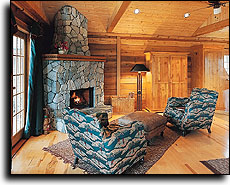 Wood burning fireplace
Wood burning fireplace
Before the 20th century, 90 percent of Americans burned wood to heat their homes. As fossil fuel use rose, the percentage of Americans using wood for fuel dropped, falling as low as one percent by 1970. Then during the energy crises of the 1970s, interest in wood heating resurfaced as a renewable energy alternative.
Air pollution, however, grew along with the renewed interest since wood burning emits air pollutants, including nitrogen oxides, carbon monoxide and particulate matter. This led the U.S. Environmental Protection Agency and many states to develop low emissions requirements for wood-burning appliances. As a result, today you can choose from a new generation of wood-burning appliances that are cleaner burning, more efficient and powerful enough to heat many average-sized, modern homes.
Altogether, the wood-burning appliance you choose, your chimney, how you maintain the system, the fire you build, the wood you use and even the safety precautions you take will determine the overall energy efficiency of wood heating.
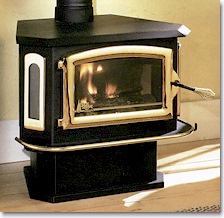 Wood stove
Wood stove
Wood-Burning Appliances
A wood-burning appliance's efficiency is a product of its combustion efficiency - how completely fuel is burned - and heat transfer efficiency - how well the device transfers heat to the home. When it comes to heat transfer, wood-burning appliances have either radiant or convective attributes - or a combination of both. Radiant devices radiate heat onto nearby objects directly. When we rub our hands in front of a fireplace, we experience radiant heat. A convective device, on the other hand, includes a heat-transfer system that circulates air through the appliance and distributes it, thus heating a home's air supply.
The location of the appliance (and chimney) will influence how well heat is distributed and conserved in your home. Wood-burning appliances are essentially space heaters. Therefore, it's best to put one in the room where you spend most of your time, but it should include a way for heat to circulate to the rest of the house.
It's also important to use a properly-sized appliance for the space to be heated. You don't want to make the mistake of purchasing one that is too big. When an appliance is too big, residents tend to burn fires at a low smolder to avoid overheating, which wastes fuel and is one of the biggest causes of air pollution. A reputable dealer should talk with you about size requirements, but here's a good rule-of-thumb: a stove rated at 60,000 British thermal units (Btu) can heat a 2,000 square foot home, while a stove rated at 42,000 Btu can heat a 1,300 square foot space. A Btu is the amount of heat needed to raise the temperature of 1 pound of water 1º F.
High-efficiency, wood-burning appliances not only have lower emissions, but they are also often safer. For example, in addition to saving energy, complete combustion helps to prevent a buildup of flammable chimney deposits called creosote. A wood-burning appliance that has been tested for safety will bear a label from a recognized authority. However, avoid buying a secondhand appliance even if it has a safety certification label. A minute flaw resulting from its previous use could result in a hazard.
For safety, and to maximize efficiency, you should consider having a professional install your wood-burning appliance. A professional will carefully evaluate everything from your chimney to your floor protection. A certified professional can also help you choose the best wood-burning appliance to heat your home. The following is a brief overview of the different types of appliances available.
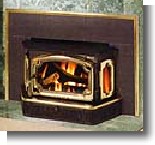 Fireplace insert
Fireplace insert
High-efficiency fireplace inserts
Designed more for show, traditional open masonry fireplaces fall at the bottom of the list in energy efficiency. On average, they are only about 10 percent efficient. In fact, conventional fireplaces can cause net heat loss because they can draw so much warm air out of a home while contributing little heat.
A few devices have been designed to improve the energy efficiency of conventional fireplaces. Of these, only high-efficiency fireplace inserts have proven effective in increasing the heating efficiency of older fireplaces. Essentially, the inserts function like woodstoves. They fit into the masonry fireplace or on its hearth, and use the existing chimney. You must install a flue collar that continues from the insert to the top of the chimney. A well-fitted fireplace insert can function nearly as efficiently as a woodstove.
High-efficiency fireplaces
Some modern fireplaces heat at efficiencies near those of woodstoves and are certified as low emission appliances. Although designed to include the fire-viewing benefits of a traditional fireplace, this generation of fireplaces can effectively provide heat as well. Through vents under the firebox, room air is drawn in, heated through a heat exchanger, and sent back into the house either through vents at the top of the fireplace or through ducts leading to nearby rooms. Some of these fireplaces are approved to route heated air to a basement auxiliary fan. The air then travels through ducts to other rooms in the house.
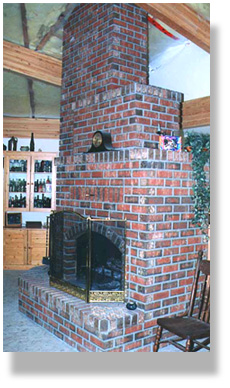 Masonry heater
Masonry heater
Masonry heaters
Masonry heaters produce more heat and less pollution than any other wood-burning appliance. They are common in Europe, but you won't find many in the United States, perhaps because of their high installation costs.
Masonry heaters include a firebox, a large masonry mass such as bricks, and long twisting smoke channels that run through the masonry mass. A small hot fire built once or twice a day releases heated gases into the long masonry heat tunnels. The masonry absorbs the heat and then slowly releases it into the house over a period of 12 to 20 hours. Masonry heaters commonly reach a combustion efficiency of 90 percent.
Advanced combustion woodstoves
Advanced combustion woodstoves provide a lot of heat but only work efficiently when the fire burns at full throttle. Also known as secondary burn stoves, they can reach temperatures of 1100° F - hot enough to burn combustible gases.
These stoves have several components that help them burn combustible gases, as well as particulates, before they can exit the chimney. Components include a metal channel that heats secondary air and feeds it into the stove above the fire. This heated oxygen helps burn the volatile gases above the flames without slowing down combustion. While many older stoves only have an air source below the wood, the secondary air source in advanced combustion stoves offers oxygen to the volatile gases escaping above the fire. With enough oxygen, the heated gases burn as well. In addition, the firebox is insulated, which reflects heat back to it, ensuring that the turbulent gases stay hot enough to burn. New advanced combustion stoves have advertised efficiencies of 60 to 72 percent.
Catalytic combustors
Many woodstoves or fireplace inserts include a catalytic combustor - a honeycomb-shaped disc covered by a rare metal like platinum - placed across the exhaust vent. The catalytic combustor lowers the temperature required for burning gases released during combustion from 1100° to 600°F.
A stove or insert with a catalytic combustor burns gases and particulates for fuel before they can escape through a chimney, as long as the fire's temperature is at least 600°F. Lower temperatures not only mean a cleaner burn but also a longer one. New catalytic stoves and inserts have advertised efficiencies of 70 to 80 percent.
Centralized wood-burning boilers
Like wood-burning appliances, centralized wood-burning boilers have been improved over the last several years. Modern, centralized wood heaters use wood gasification technology that burns both the wood fuel and the associated combustible gases, rendering them efficient up to 80 percent. In addition, systems are available that can switch to oil or gas if the fire goes out.
The Chimney
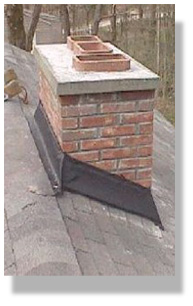 Chimney's should be inspected
Chimney's should be inspected
Chimneys harness the heat of the fire to create what's called a stack effect. As the warm air from the fire rises, cooler house air rushes into the wood-burning appliance through vents, providing the oxygen the fire needs to burn. Starting a fire with a good hot burn will encourage this healthy draft to flow. Also, between the higher and lower pressure zones of the home lies a neutral pressure zone. The neutral pressure zone tends to move toward the largest air leak. When the top of the chimney is located above the home ceiling (as it should be), the chimney's neutral pressure zone is above the neutral pressure zone of the house. Such proper chimney placement creates a gentle flow of air into the appliance and out the chimney even when no fire burns.
If you are designing or building a new home, consider placing the chimney inside your home. A more traditional chimney, constructed along the outside of a home, will lose valuable heat to the cold, outside air. If the chimney air temperature falls below that of the inside air, the cold, smelly chimney air will be pulled into the house by the low pressure of the stack effect. In such a scenario, the house has become a better chimney than the chimney. So when a fire is lit, smoke fills the room.
Chimneys must match the size of the appliance, meaning the flue size should match the stove outlet. If the chimney is bigger than the stove or fireplace outlet, exiting exhaust slows, increasing creosote buildup and decreasing efficiency. High-performance chimneys are also insulated. Older masonry chimneys can be relined to safely and efficiently connect them to newer high-efficiency, wood-burning appliances. Again, the chimney liner should be continuous from the appliance outlet to the chimney top. It is not uncommon to pay as much for the chimney as for your appliance.
Free-standing woodstoves exhaust into a connecting pipe, which then connects into the chimney. If the connecting pipe is longer than 8 feet (as in a vaulted ceiling), you should consider investing in double-layer pipe with 1-inch airspace between pipe layers. Efficient modern stoves produce large amounts of heat. Much of this heat can radiate from a longer length of single-layer pipe, slowing down the draft, which can impact the overall efficiency of your wood-burning system.
Maintenance
 Cleaning a chimney prevents fires
Cleaning a chimney prevents fires
To keep your wood-burning system operating efficiently and safely, you'll need to maintain it on a regular basis.
Every year, preferably before each heating season, have a chimney sweep certified by the Chimney Safety Institute of America inspect your wood-burning system. In addition to cleaning the chimney, a certified chimney sweep should have the knowledge to help make sure your appliance, hearth, connecting pipe, air inlets, chimney and all other components are functioning efficiently and safely.
Catalytic combustors need to be inspected at least three times every heating season and replaced according to the manufacturer's recommendations.
Cleaning out the inside of the appliance with a wire brush periodically will also help your wood-burning appliance heat your home efficiently. Even a one-tenth inch of soot can drop the heat transfer efficiency of the metal by 50 percent.
The Fire
When wood burns, it goes through three phases. First, the heat of the fire evaporates the water in the wood. It takes a lot of energy to evaporate water, so excess moisture in the wood wastes much of the heat energy of your fire. Wet wood also often smolders, causing unburned tar deposits of creosote to build up in the chimney, which is then vulnerable to fire.
Next, the wood begins to decompose and vaporizes into smoke. Smoke, a combination of combustible gases and tar droplets, will also burn if enough oxygen is present. Burning smoke produces the bright flames we associate with a well-burning fire.
In the final phase, the charcoal, which is nearly pure carbon, burns. This pure carbon represents roughly 50 percent of the fuel available from burning wood. The other 50 percent of available energy is stored in the smoke, which is why recent developments in wood-burning technology have focused on burning 100 percent of the wood and smoke.
Selecting and storing the wood
Because a lot of energy can be wasted burning wet wood, you should use wood that has been properly seasoned. Properly seasoned wood is harvested in the spring and allowed to dry throughout the summer. Look for wood that is of even color, without any green. It should have a moisture content of just over 20 to 25 percent by weight. Some well-seasoned wood can in fact be too dry for today's airtight modern stoves. If you place wood that is too dry on a bed of coals, it will instantly give up its gases as smoke, wasting unburned smoke and producing creosote buildup.
 Store wood away from the house
Store wood away from the house
All species of wood have a similar heat content on a per pound basis when completely dry. Therefore, denser woods will generally cost more and burn longer. Woods like oak, hickory, and pine will burn overnight. Aspen builds a hot fire, which helps clean the chimney.
When selecting wood, you might also want to find out whether the supplier uses sustainable harvesting practices. Unsustainable practices can negatively impact the environment, causing soil erosion and loss of biodiversity. At least ascertain that the wood was not the result of clear-cutting. Clear-cutting is when all, or nearly all, of the trees are cut down on a piece of land.
Store your wood away from the house in case termites discover the woodpile. The top of the pile should be covered, but leave the sides open so air can circulate. If possible, store the wood a foot off the ground to keep it dry.
Building the fire
How a fire is built affects its efficiency. Fire-building techniques abound, so it's best to learn what type of fire is best for your particular appliance. As a general rule, though, when solid wood is present you should see flames. You want to avoid a smoldering fire.
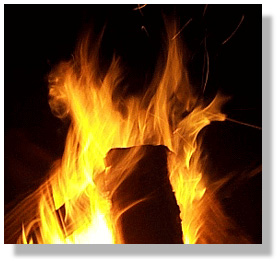 Seasoned wood is the key to a good fire
Seasoned wood is the key to a good fire
Build a hot fire with temperatures high enough to burn off smoke. Unburned smoke -common to smoldering fires - escapes to the chimney where it will condense to form creosote or exit as air pollution. A strong hot fire will also help kick in the chimney draft, which gets air flowing into the fire and out the chimney.
Here's one technique for building a good, strong fire quickly. First, find the air source. If your appliance has a damper, make sure that it's fully open. Near the air source, crumple a generous amount of plain newspaper and add some finely split dry kindling, such as cedar or pine and one or two small pieces of seasoned firewood. You can also use a fire starter made for indoor wood-burning appliances to help skip the smoldering phase and get the fire roaring quickly.
Ideally, one match should start your fire. Keep the appliance doors open slightly. High airflow allows for maximum oxygen supply, which gets the fire hot quickly. When adding new wood pieces, place them behind the fire rather than on top to avoid smothering it. Make sure to leave an inch between all wood pieces to allow oxygen to reach the wood. When the fire really gets going, the chimney draft will kick in and provide a steady oxygen supply to the fire. You can then close the appliance doors.
Safety
Burning wood requires careful attention to safety. Professional installation, regular maintenance and inspection by a certified
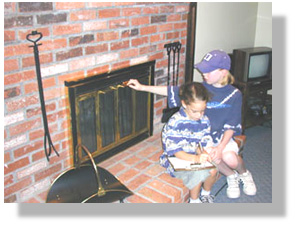 Inspect your fireplace and use a checklist
Inspect your fireplace and use a checklist
chimney sweep and attentive operation will all help you enjoy your wood-burning appliance in safety. Here are a few other important things to remember:
Always
- Attend your fire anytime the appliance doors are open. For open fireplaces, use a screen whenever possible. Sparks can fly, and coals can leap out of fireboxes.
- Make sure you have adequate floor protection.
- Make sure you have a working fire alarm, fire extinguisher and carbon monoxide detector.
- Burn properly seasoned firewood.
- Start with a hot fire to get a good draft going in your chimney. Back drafts can result in carbon monoxide entering your home.
- Avoid smoldering fires that can lead to buildup of flammable deposits called creosote.
Never
- Use lighter fluid or other petroleum-based products to start your indoor fire.
- Burn anything but untreated firewood or kindling, manufactured fire logs, indoor fire starters, or newspaper in your wood-burning appliance. Treated woods and other odd items such as plastics or other debris can release toxic chemicals into the air or into your home.
- Place wooden or other flammable objects near the wood-burning appliance.
- Use cardboard or wrapping paper to start fires, as these can spark a chimney fire.
Home
Energy Loans
Energy Statistics
 State of Nebraska Home
Disclaimer
Webmaster
State of Nebraska Home
Disclaimer
Webmaster
| |
 Wood burning fireplace
Wood burning fireplace Wood stove
Wood stove Fireplace insert
Fireplace insert Masonry heater
Masonry heater Chimney's should be inspected
Chimney's should be inspected Cleaning a chimney prevents fires
Cleaning a chimney prevents fires  Store wood away from the house
Store wood away from the house Seasoned wood is the key to a good fire
Seasoned wood is the key to a good fire Inspect your fireplace and use a checklist
Inspect your fireplace and use a checklist![]() State of Nebraska Home
Disclaimer
Webmaster
State of Nebraska Home
Disclaimer
Webmaster